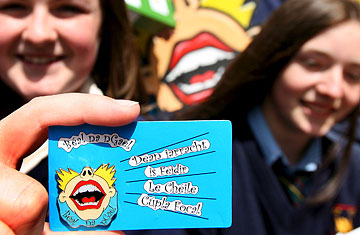
Students in Dublin hold up an Irish language badge that they designed to encourage young people to speak Irish, the national language
After decades of exodus, the tide of Irish migration took a definitive turn in the late 1980s, when the Irish diaspora started to come home. Maebh Walsh was one of those who returned. The 49-year-old designer decided to move back to Dublin after years living in Arizona. Walsh says living abroad for so long caused her family to return "more aware of our background and our 'Irishness.' So when we came back in 1988 and had children, we wanted them to have our culture."
And so Walsh, like more and more Irish parents, sends her children to a school where all the lessons are taught in Irish — Ireland's indigenous Celtic language. Over the past decade, gaelscoileanna, as the schools are called, have become one of the fastest-growing sectors in Irish education. And though they still only comprise 5% of Ireland's schools, their number has tripled since the early 1990s.
The explosion in gaelscoileanna is part of an Irish-language renaissance that's been building over the past twenty years. Centuries of colonization left Ireland with a severely depleted population of Irish speakers by the time it gained independence from Britain in 1922. For decades after, the language was ghettoized in remote, rural pockets of the country and weighed down by associations with poverty or sectarian extremism. Today, between 5 and 10% of the 4.2 million people living in Ireland speak Irish on a daily basis, and many of those are students who only speak it in school. Máire Nic Ghiolla Phádraig, senior lecturer of sociology at University College Dublin, witnessed the impact of the rise in gaelscoileanna on her university campus with more and more gaelgóirs, or Irish speakers, arriving each year. "I have seen the change during Fresher's week," Nic Ghiolla Phádraig says. "Hundreds of Irish speakers join the Cumann Gaeleach [Irish club] and wearing "Grá don Gaeilge" ["I Heart Irish"] stickers. It's no longer regarded as 'uncool' to speak Irish."
But the rise of the old tongue has some worried about a potentially new conflict: that the increasing number of gaelscoileanna will pit Ireland's constitutional vow to preserve its "native" language against the obligation as a modern country to integrate its increasing immigrant population. While Walsh and hundreds of thousands of other Irish were making their way home, other, newer migration paths were being cut from China, Nigeria, Poland and many other countries. Between the late 1980s and today, the percentage of foreign-born residents in Ireland grew from around 1% to almost 12%. "People choose gaelscoileanna for all kinds of reasons, but realistically it would rarely be the first choice for newly arrived immigrants," says Colette Kavanagh, a principal at Esker Educate Together School in Lucan, a commuter town outside of Dublin.
That disconnect, says Kavanagh, could engender a defacto segregation in the Irish school system — and a potentially unfair distribution of more resources to Irish schools. "These schools could unintentionally lead to a kind of white flight from English-language education," she says. At Kavanagh's English-speaking school, one of the most diverse in the country, 95% of the students are children of immigrants. At the nearest Irish-language school, only 5% of the student body is foreign-born.
Sociologists say Ireland's linguistic renaissance and the nation’s spike in immigration are both triggered in part by the 'Celtic Tiger' — the growth phenomenon that has seen the Irish economy mushroom by over 150% since 1995. Years of EU infrastructural and educational support and a young and cheap labor force made Ireland a fertile ground for foreign investment in the domestic IT sector, among other industries, and the result has seen the average annual family income double to $93,000 in the past 10 years. Nic Ghiolla Phádraig says this new prosperity brought a sense of pride and self-assurance that prompted a rediscovery in Ireland's "cultural assets" — Irish being one of them.
In places like Ennis, a town in southwest Ireland, immigrants are beginning to claim those assets for themselves. Like Lucan, the town’s population has also radically diversified over the past decade. Schools have shifted gears accordingly, setting aside a minimum of 5% of places to foreign-born students. The town's Irish language school, Gaelscoil Mhíchíl Cíosóg, surpassed the figure this year, with 10% of its admissions made up of children of immigrant parents — Nigerian, Polish, Dutch, Ghanaian and Spanish among them. Initially, says principal Dónal O hAiniféin, the school was not an obvious choice for immigrants, but as their communities put down roots, "They tell me, 'My child is Irish, I'd like him or her to be fluent in the Irish language.'" Schools around Ennis are now discussing raising the required minority admission rate to 25% in 2009.
As targets like these continue to be pursued nationwide, it may, in fact, be the new Ireland that helps this old language grow. Michal Boleslav Mechura, a 33-year-old resident of Dublin who immigrated from the Czech Republic ten years ago, became fluent in Irish and finds it useful in his own integration process. "People don't realize I'm not from here when I speak in Irish," Mechura says. "A lot of Irish people who speak Irish speak it as a second language and so we are all on the same footing. I fit in better in Irish."
